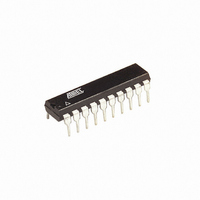ATTINY26-16PI Atmel, ATTINY26-16PI Datasheet - Page 83

ATTINY26-16PI
Manufacturer Part Number
ATTINY26-16PI
Description
IC AVR MCU 2K 16MHZ IND 20-DIP
Manufacturer
Atmel
Series
AVR® ATtinyr
Specifications of ATTINY26-16PI
Core Processor
AVR
Core Size
8-Bit
Speed
16MHz
Connectivity
USI
Peripherals
Brown-out Detect/Reset, POR, PWM, WDT
Number Of I /o
16
Program Memory Size
2KB (1K x 16)
Program Memory Type
FLASH
Eeprom Size
128 x 8
Ram Size
128 x 8
Voltage - Supply (vcc/vdd)
4.5 V ~ 5.5 V
Data Converters
A/D 11x10b
Oscillator Type
Internal
Operating Temperature
-40°C ~ 85°C
Package / Case
20-DIP (0.300", 7.62mm)
Lead Free Status / RoHS Status
Contains lead / RoHS non-compliant
- Current page: 83 of 182
- Download datasheet (3Mb)
1477K–AVR–08/10
• Bit 5..4 – USIWM1..0: Wire Mode
These bits set the type of wire mode to be used. Basically only the function of the outputs are
affected by these bits. Data and clock inputs are not affected by the mode selected and will
always have the same function. The counter and Shift Register can therefore be clocked
externally, and data input sampled, even when outputs are disabled. The relations between
USIWM1..0 and the USI operation is summarized in Table 39.
When Two-wire mode is selected, the USISIF flag is set (to one) when a start condition is
detected. When output disable mode or Three-wire mode is selected and (USICSx = 0b11 &
USICLK = 0) or (USICS = 0b10 & USICLK = 0), any edge on the SCK pin sets the flag.
Table 39. Relations between USIWM1..0 and the USI Operation
Note:
USIWM1
0
0
1
1
1. The DI and SCK pins are renamed to Serial Data (SDA) and Serial Clock (SCL) respectively to
avoid confusion between the modes of operation.
USIWM0
0
1
0
1
Description
Outputs, clock hold, and start detector disabled. Port pins operates as
normal.
Three-wire mode. Uses DO, DI, and SCK pins.
The Data Output (DO) pin overrides the PORTB1 bit in the PORTB
Register in this mode. However, the corresponding DDRB1 bit still
controls the data direction. When the port pin is set as input
(DDRB1 = 0) the pins pull-up is controlled by the PORTB1 bit.
The Data Input (DI) and Serial Clock (SCK) pins do not affect the
normal port operation. When operating as master, clock pulses are
software generated by toggling the PORTB2 bit while DDRB2 is set to
output. The USITC bit in the USICR Register can be used for this
purpose.
Two-wire mode. Uses SDA (DI) and SCL (SCK) pins
The Serial Data (SDA) and the Serial Clock (SCL) pins are bi-
directional and uses open-collector output drives. The output drivers
are enabled by the DDRB0/2 bit in the DDRB Register.
When the output driver is enabled for the SDA pin, the output driver
will force the line SDA low if the output of the Shift Register or the
PORTB0 bit in the PORTB Register is zero. Otherwise the SDA line
will not be driven (i.e., it is released). When the SCL pin output driver is
enabled the SCL line will be forced low if the PORTB2 bit in the
PORTB Register is zero, or by the start detector. Otherwise the SCL
line will not be driven.
The SCL line is held low when a start detector detects a start condition
and the output is enabled. Clearing the start condition flag (USISIF)
releases the line. The SDA and SCL pin inputs is not affected by
enabling this mode. Pull-ups on the SDA and SCL port pin are
disabled in Two-wire mode.
Two-wire mode. Uses SDA and SCL pins.
Same operation as for the Two-wire mode described above, except
that the SCL line is also held low when a counter overflow occurs, and
is held low until the Counter Overflow Flag (USIOIF) is cleared.
(1)
.
83
Related parts for ATTINY26-16PI
Image
Part Number
Description
Manufacturer
Datasheet
Request
R

Part Number:
Description:
Manufacturer:
Atmel Corporation
Datasheet:

Part Number:
Description:
IC AVR MCU 2K 16MHZ IND 32-QFN
Manufacturer:
Atmel
Datasheet:

Part Number:
Description:
IC AVR MCU 2K 16MHZ IND 20-SOIC
Manufacturer:
Atmel
Datasheet:

Part Number:
Description:
IC AVR MCU 2K 16MHZ IND 20-DIP
Manufacturer:
Atmel
Datasheet:

Part Number:
Description:
IC AVR MCU 2K 16MHZ IND 32-QFN
Manufacturer:
Atmel
Datasheet:

Part Number:
Description:
IC AVR MCU 2K 16MHZ COM 20-SOIC
Manufacturer:
Atmel
Datasheet:

Part Number:
Description:
IC AVR MCU 2K 16MHZ IND 20-SOIC
Manufacturer:
Atmel
Datasheet:

Part Number:
Description:
ID MCU AVR 2K 5V 16MHZ 32-QFN
Manufacturer:
Atmel
Datasheet:

Part Number:
Description:
Microcontrollers (MCU) AVR 2K FLASH 128B EE 128B SRAM ADC
Manufacturer:
Atmel
Datasheet:

Part Number:
Description:
IC AVR MCU 2K 16MHZ COM 32-QFN
Manufacturer:
Atmel
Datasheet:

Part Number:
Description:
IC AVR MCU 2K 16MHZ COM 20-DIP
Manufacturer:
Atmel
Datasheet:

Part Number:
Description:
ID MCU AVR 2K 5V 16MHZ 20-DIP
Manufacturer:
Atmel
Datasheet:

Part Number:
Description:
ID MCU AVR 2K 5V 16MHZ 20-SOIC
Manufacturer:
Atmel
Datasheet:

Part Number:
Description:
IC MCU AVR 2K 16MHZ IND 20SOIC
Manufacturer:
Atmel
Datasheet:










